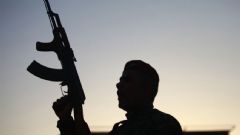Share
Human Rights Voices
While the UN devotes its human rights operations to the demonization of the democratic state of Israel above all others and condemns the United States more often than the vast majority of non-democracies around the world, the voices of real victims around the world must be heard.
Islamic State, June 27, 2014
Iraq Militants Executed At Least 160 Captives
Original source
Iraqi insurgents executed at least 160 captives earlier this month in the northern city of Tikrit, Human Rights Watch said Friday, citing an analysis of satellite imagery and grisly photos released by the militants.
The U.S.-based rights group said militants from the Islamic State of Iraq and the Levant killed between 160 and 190 men in two locations in Tikrit between June 11 and June 14. "The number of victims may well be much higher, but the difficulty of locating bodies and accessing the area has prevented a full investigation," it said.
After overrunning large swaths of northern Iraq and capturing the cities of Mosul and Tikrit earlier this month, the Islamic extremist group posted graphic photos on a militant website that appeared to show fighters loading dozens of captured soldiers onto flatbed trucks before forcing them to lie in a shallow ditch with their hands tied behind their backs. A final set of photos shows bodies.
"The photos and satellite images from Tikrit provide strong evidence of a horrible war crime that needs further investigation," Peter Bouckaert, emergencies director at Human Rights Watch, said in a statement.
Chief Iraqi military spokesman Lt. Gen. Qassim al-Moussawi confirmed the photos' authenticity on June 15, after they first surfaced, and said he was aware of cases of mass murder of captured Iraqi soldiers in areas held by the Islamic State.
He told The Associated Press at the time that an examination of the images by military experts showed that about 170 soldiers were shot to death after their capture.
Captions on the photos showing the soldiers after they were shot say "hundreds have been liquidated," but the total could not be verified.
The massacre appeared to be aimed at instilling fear in Iraq's demoralized armed forces -- which melted away as militants seized much of the north in a matter of days -- as well as the country's Shiite majority, whom the Islamic State views as apostates.
"This is the fate that awaits the Shiites sent by Nouri to fight the Sunnis," one caption read, apparently referring to Prime Minister Nouri al-Maliki.
The rapid advance of the Islamic State and allied Sunni militants has ignited sectarian tensions, with heavily armed Shiite militias vowing to defend Baghdad and revered shrine cities to the south. On Thursday a bombing killed 12 people in a Shiite neighborhood of Baghdad that houses a revered shrine, and police found the bullet-riddled bodies of eight Sunnis south of the capital.
Prominent Shiite leaders are meanwhile pushing for the removal of al-Maliki, who has come under mounting pressure to reach out to the country's disaffected Sunni and Kurdish minorities and rapidly form a unified government following April's parliamentary elections.
Even al-Maliki's most important ally, neighboring Iran, is said to be looking at alternatives.
A senior Iranian general who met with Shiite politicians in Iraq during a 10-day visit this month returned home with a list of potential prime minister candidates for Iran's leadership to consider, several senior Iraqi Shiite politicians who have knowledge of the general's meetings told The Associated Press on Thursday.
The general, Ghasem Soleimani, is expected to return within days to inform Iraqi politicians of Tehran's favorite, they said, speaking on condition of anonymity to discuss the internal deliberations.
The rapid advance of the Islamic State of Iraq and the Levant in the north as well as the restive western Anbar province has plunged Iraq into its worst crisis since U.S. troops withdrew in 2011 and raised fears of a region-wide conflict. The radical group has carved out a self-styled Islamic state straddling the Syrian-Iraqi border, where it has imposed a brutal version of Shariah law.
Russia's U.N. ambassador said Thursday that there is a real prospect of a terrorist state springing up from Syria's second-largest city Aleppo to Iraq's capital Baghdad.
Vitaly Churkin, the current president of the U.N. Security Council, said he told the 14 other council members that a terrorist state "is a very, very serious prospect" that the council needs to address "because really we are lagging behind ... in our responses."
He argued that Russia's support for President Bashar Assad's government in Syria was aimed at preventing the Islamic State from taking over.
The United States is also looking to Syria, with President Barack Obama requesting $500 million to arm and train moderate Syrian rebels in the hopes of opening up a new front against the Islamic State, which has been at war with other Islamic and secular rebel groups since the start of the year.
The rebel groups turned on the Islamic State because of its alleged brutality toward rivals and activists. Massacres like the one depicted in the online photos from Iraq could alienate some Sunnis while emboldening the armed forces and Shiite militias.
Human Rights Watch said that using satellite imagery from 2013 and publicly available photos taken earlier, it was able to pinpoint the execution site in a field near a former palace of the late dictator Saddam Hussein, next to the Tigris river.
It said satellite imagery of the site from June 16 did not reveal bodies but showed indications of vehicles and earth movement consistent with the two shallow trenches visible in the photos.

